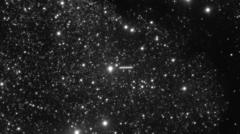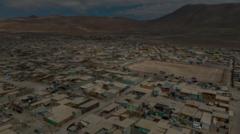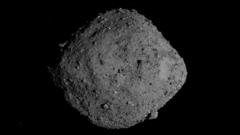The recent discovery of an interstellar object named 3I/ATLAS has stirred the scientific community, as it may represent the oldest comet ever identified. According to researchers from Oxford University, this intriguing object could predate our solar system by as much as three billion years. Detected for the first time on July 1, 2025, by the ATLAS survey telescope in Chile from a distance of about 670 million kilometers from the Sun, 3I/ATLAS marks only the third known interstellar visitor to pass through our solar system.
Matthew Hopkins, an astronomer from the University of Oxford, expressed excitement over the object, indicating its age may exceed seven billion years. "It's an extraordinary instance of an interstellar traveler," he remarked shortly after the object’s discovery, which coincided with the culmination of his PhD studies.
Initial assessments, presented Friday at the Royal Astronomical Society's national meeting in Durham, propose that the comet originates from the thick disk of the Milky Way, an area densely populated with ancient stars. The composition of 3I/ATLAS is believed to be rich in water ice from its formation around a distant star. As the comet approaches the Sun later this year, the rising temperatures should trigger dramatic emissions of vapor and dust, potentially creating a spectacular tail.
The research team utilized a novel modeling approach developed by Hopkins to analyze the comet's characteristics. “This is an object from a part of the galaxy we’ve never seen up close before,” noted Professor Chris Lintott, a co-author of the study. The team estimates there’s a two-thirds likelihood that this comet is older than the solar system itself, floating through the cosmos for eons.
3I/ATLAS is expected to be visible from Earth through amateur telescopes later this year, presenting an exciting opportunity for enthusiasts and scientists alike. Prior to this comet's discovery, only two interstellar objects had been recorded: 1I/'Oumuamua in 2017 and 2I/Borisov in 2019.
In a significant advancement for astronomical research, the Vera C Rubin Telescope in Chile is set to commence operations soon. Scientists anticipate it will be capable of identifying anywhere from five to fifty new interstellar objects as it begins surveying the southern night sky. The implications of these discoveries for our understanding of the cosmos are boundless, offering potential revelations about the origins of water in the universe and the primal history of our galaxy.
Matthew Hopkins, an astronomer from the University of Oxford, expressed excitement over the object, indicating its age may exceed seven billion years. "It's an extraordinary instance of an interstellar traveler," he remarked shortly after the object’s discovery, which coincided with the culmination of his PhD studies.
Initial assessments, presented Friday at the Royal Astronomical Society's national meeting in Durham, propose that the comet originates from the thick disk of the Milky Way, an area densely populated with ancient stars. The composition of 3I/ATLAS is believed to be rich in water ice from its formation around a distant star. As the comet approaches the Sun later this year, the rising temperatures should trigger dramatic emissions of vapor and dust, potentially creating a spectacular tail.
The research team utilized a novel modeling approach developed by Hopkins to analyze the comet's characteristics. “This is an object from a part of the galaxy we’ve never seen up close before,” noted Professor Chris Lintott, a co-author of the study. The team estimates there’s a two-thirds likelihood that this comet is older than the solar system itself, floating through the cosmos for eons.
3I/ATLAS is expected to be visible from Earth through amateur telescopes later this year, presenting an exciting opportunity for enthusiasts and scientists alike. Prior to this comet's discovery, only two interstellar objects had been recorded: 1I/'Oumuamua in 2017 and 2I/Borisov in 2019.
In a significant advancement for astronomical research, the Vera C Rubin Telescope in Chile is set to commence operations soon. Scientists anticipate it will be capable of identifying anywhere from five to fifty new interstellar objects as it begins surveying the southern night sky. The implications of these discoveries for our understanding of the cosmos are boundless, offering potential revelations about the origins of water in the universe and the primal history of our galaxy.


















